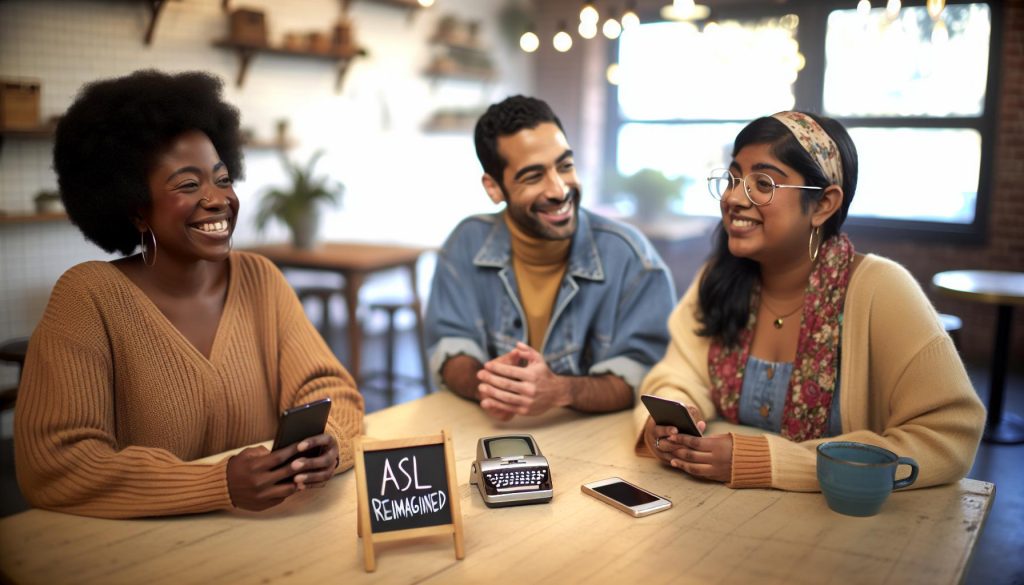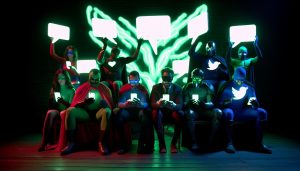Did you know that social media slang can sometimes come from unexpected places? As the internet evolves, so does its language, and Twitter is buzzing with a revival of ASL-American Sign Language-slang. This old-school lingo not only adds flavor to our tweets but also transforms how we engage with and understand each other in a digital world.
In today’s fast-paced online ecosystem, learning the nuanced meaning behind ASL slang can boost your Twitter game, making your interactions more relatable and fun. Whether you’re a seasoned Twitter veteran or a newcomer trying to decipher the latest trends, understanding this slang enhances communication and fosters connection. So, why is this throwback to ASL slang making a comeback now? Let’s dive in and explore how this trend captures the essence of modern digital expression and why it matters for anyone wanting to stay in-the-know.
The Resurgence of ASL Slang on Twitter
In the ever-evolving landscape of social media, ASL slang has made a vibrant comeback on Twitter, much like that retro fashion trend you didn’t know you needed. As younger audiences embrace platforms where video content reigns supreme, the use of American Sign Language has surged-infusing creativity and authenticity into digital communication. But why is this happening? Simply put, ASL slang offers a fun, quick way to convey emotions and ideas in a visually expressive format.
Social media users are becoming increasingly aware of the cultural significance embedded in ASL. For example, the incorporation of signs in memes or relatable content not only boosts engagement but fosters an inclusive environment. When creators introduce ASL alongside trending topics or notable events, it encourages a broad audience to explore and appreciate sign language, ultimately breaking down barriers.
To tap into this resurgence of ASL slang, consider using popular hashtags like #ASL and #DeafTikTok. This will connect you with vibrant communities dedicated to sharing and celebrating ASL. Plus, adding ASL to your digital vocabulary can enrich your interactions! Create a list of current ASL terms or phrases that reflect your personality, and start incorporating them into your tweets. Not only will this amplify your posts, but it can also spark meaningful conversations around inclusion and representation.
Whether you’re casually browsing Twitter or looking to engage on a deeper level, embracing ASL slang is a playful yet impactful way to participate in online discussions-keeping your communication fresh and relevant. Dive into the trend, and watch your digital presence transform with new layers of creativity and connection.
Understanding ASL: Origins and Evolution
The rich tapestry of American Sign Language (ASL) stretches back over a century, weaving together the vibrant threads of Deaf culture, community identity, and linguistic evolution. Originally rooted in regional sign languages from communities across the United States, ASL emerged as a distinct language through the establishment of schools for the Deaf in the early 19th century. Prominent figures such as Thomas Gallaudet and Laurent Clerc played pivotal roles in formalizing ASL by creating a structured method of communication that combined gestures with manual signs influenced by French Sign Language.
As ASL evolved, it absorbed elements from local dialects and the unique experiences of Deaf communities, leading to a dynamic language that’s not only communicative but also expressive and rich in cultural nuance. Interestingly, while ASL has a formal structure, its informal register has given rise to a plethora of slang and colloquial signs. This is particularly true in the age of social media, where concise communication is key. The return of ASL slang on platforms like Twitter mirrors interactions in spoken languages, embodying trends, humor, and shared experiences among users.
In today’s digital landscape, ASL continues to adapt and thrive. With the popularity of video-sharing platforms and the viral nature of memes, the language finds new life as users share signs that resonate within pop culture. ASL slang not only serves as a linguistic shortcut but also strengthens connections within the growing Deaf and hearing-impaired communities, promoting understanding and inclusivity among a broader audience. Engaging with ASL on social media allows for both expression and education, making the language accessible and relevant to a new generation hungry for authentic connections.
Integrating ASL into digital conversations is akin to adding a distinctive flair to your tweets. Users are increasingly seeking authenticity in their interactions, and employing ASL slang is one vibrant way to express individuality while celebrating Deaf culture. This blend of heritage and modernity not only enriches online dialogue but also revitalizes the appreciation for ASL, encouraging broader engagement and celebrating its rightful place in the linguistic landscape of our time.
How ASL Slang Influences Online Conversations
The online world thrives on shortcuts, and what’s quicker than a cool sign? ASL slang has burst onto the Twitter scene like a meme at a party, giving users a vibrant way to communicate. Just as acronyms and emojis have transformed text-based conversations, ASL slang serves as a dynamic cultural bridge, connecting users with both Deaf and hearing communities. This return to old-school ASL terms isn’t just catchy-it’s a way of celebrating identity and enhancing the richness of our online exchanges.
Using ASL slang in tweets isn’t merely about expressing oneself; it’s about fostering a sense of belonging and cultural pride. For example, a quick sign for “thank you” or “cool” can punctuate a tweet with authenticity. It’s like tossing in a little flair to make your point resonate. And let’s not forget that the visual nature of ASL is a perfect match for the multimedia landscape of platforms like Twitter, where images, gifs, and videos can enhance the impact of what you’re trying to say. By adding ASL signs into the mix, users can share viral content that promotes awareness and inclusivity within their networks.
To make the most out of ASL slang on Twitter, consider these tips for effective communication:
- Be Visual: Use videos or GIFs that show the signs you’re mentioning. Nothing beats the clarity of a visual expression!
- Engage with the Community: Follow ASL content creators, participate in trending challenges, and interact with hashtags related to Deaf culture.
- Stay Updated: Watch for viral ASL trends and new slang that pop up. Social media evolves quickly, and keeping up with fresh expressions is part of the fun!
- Educate Your Followers: When you use ASL slang, consider adding a quick explanation or a link to resources for followers unfamiliar with the signs. It fosters inclusivity!
ASL slang is more than just a trend; it’s a cultural revival that speaks to the heart of digital communications. By integrating these signs into tweets, users can participate in an ongoing conversation that values authenticity, expresses individuality, and strengthens community ties. So go ahead, add a dash of ASL to your Twitter game-it’s not just a trend; it’s a celebration of a rich linguistic heritage!
Key ASL Terms Trending on Twitter Today
In the whirlwind of Twitter updates, ASL terms have taken on a vibrant new life, morphing into the flashiest form of communication. These signs, often steeped in rich cultural context, are getting a modern makeover that resonates with the generations who grew up in the digital era. Among the rising stars of ASL slang trending on Twitter today, terms like “fire” (for something cool or exciting) and “no cap” (to mean no lie) are making waves, illustrating how traditional signs can embody contemporary slang. This combination creates a playful, dynamic language that feels right at home in today’s meme-centric online culture.
Users are diving into these ASL terms not merely for the novelty but for their capacity to encapsulate emotion and clarity in a single visual gesture. The sign for “thank you,” for example, isn’t just a way to convey gratitude; it transforms the digital conversation, adding a personal touch that helps build connections within the community. Plus, the adaptability of ASL allows for more personalized expressions that can have variations based on locale or individual interpretation, encouraging creativity among users.
As you explore these trending terms, consider integrating them into your tweets to enhance engagement and visibility. Here’s a lineup of key ASL terms that are currently making rounds on Twitter:
- Fire: Representing something super cool or exciting.
- No Cap: A phrase signaling honesty or seriousness.
- Flex: To show off, often used in contexts of pride or success.
- Bet: A term of agreement or affirmation, signaling readiness.
Engaging with these terms not only helps bridge the gap between the Deaf and hearing communities but also signifies a cultural renaissance where ASL is celebrated as part of Internet vernacular. So next time you tweet, dare to sprinkle in some ASL magic-your posts will resonate on a deeper level, enhancing clarity while showcasing a vibrant community that values inclusivity and creativity!
The Role of ASL in Digital Communication
In the fast-paced world of digital communication, ASL (American Sign Language) shines as a unique beacon that transcends traditional text and voice. Imagine condensing your thoughts into powerful visual gestures; that’s exactly what ASL brings to platforms like Twitter, where every character counts and engagement is key. This revival of ASL slang is not just a trend; it’s a cultural phenomenon that resonates deeply within the Deaf community and beyond, creating a vibrant dialogue that enriches everyone’s online experience.
The beauty of ASL in digital conversations lies in its ability to pack a punch with minimal effort. A single sign can convey a wide range of emotions or concepts, simplifying communication while simultaneously adding depth. For example, the sign for “shook” can represent being startled or surprised in a fun, visual way that plain text struggles to achieve. When users incorporate ASL terms into tweets, they enhance expression and foster a sense of community that words alone might dilute. This visual language invites everyone, regardless of hearing ability, to participate in the conversation, breaking down barriers and building connections.
Moreover, ASL’s growth in the digital space reflects a broader shift toward inclusivity. As more users embrace ASL, it promotes a culture of accessibility, encouraging non-Deaf individuals to learn and appreciate the nuances of this beautiful language. Engaging with ASL doesn’t just enrich conversations; it fosters an environment where diverse expressions are celebrated. So, whether you’re dropping a “bet” to affirm a friend’s plan or using “fire” to hype up a trending topic, you’re not just communicating-you’re building a space where everyone can feel seen and valued.
Remember, in the whirlwind of tweets and emojis, every gesture carries weight. The next time you tweet, consider adding an ASL sign-it’s not merely about what you say, but how you say it that can amplify your message and resonate with your audience. With ASL, your words become gestures that draw people in, ensuring your posts don’t just pass by, but create ripples in the digital sea. So go ahead, sprinkle in some ASL magic-it’s all part of the experience, and who knows? You might just start a trend of your own!
Impact of ASL on Cultural Identity and Inclusion
In a world dominated by text and sound, the resurgence of ASL (American Sign Language) on platforms like Twitter is like a breath of fresh air, bridging gaps and redefining cultural identity. This visual language not only enhances communication but also amplifies the voices of the Deaf community, creating a tapestry of inclusion and expression that resonates with young people seeking connection and authenticity. By incorporating ASL into tweets, users are not just using a language; they are actively participating in the reclamation of cultural identity, celebrating diversity in a way that’s engaging and approachable.
ASL serves as a powerful tool for fostering connections within and beyond the Deaf community. When users share ASL signs alongside their thoughts, they are creating a visual representation of their identity and values. This practice encourages an appreciation for the language and culture that often goes unnoticed in mainstream conversations. For example, when a trending tweet incorporates the sign for “love” (a gesture that embodies deep affection), it resonates with a universal emotion, inviting everyone-from deaf to hearing individuals-to engage with the content on a more profound level. This cross-pollination of cultures promotes understanding and awareness, making everyone feel included.
Moreover, ASL’s presence on Twitter encourages the exploration of identity in a digital landscape that often favors the loudest voices. Younger audiences are drawn to ASL slang because it feels both personal and empowering. It’s a playful yet sincere way to express feelings, share jokes, and connect with others-something increasingly important in an age where authenticity is a prized commodity. When users participate in ASL memes or trending ASL interpretations of slang, they are not just enjoying a moment; they are contributing to a larger narrative where Deaf culture is valued and celebrated.
Ultimately, the is about more than just language; it’s a movement. As more Twitter users embrace ASL and its vibrant vernacular, they help to dismantle stereotypes and elevate the Deaf community’s visibility. By using ASL slang, everyone on the platform can contribute to a culture that acknowledges diverse identities and expressions, creating a space where everyone feels valued. So, whether you’re slinging some classic ASL terms or keeping it trendy with the latest slang, remember that each sign you share is a building block in a community that thrives on connection, understanding, and inclusion.
Why ASL Slang Resonates with Younger Audiences
In the digital age, where memes and quick bursts of communication reign supreme, ASL slang has resurfaced on platforms like Twitter, captivating younger audiences in a big way. The charm of ASL slang lies in its visual creativity-it’s a dynamic form of expression that transcends mere words. Young people are naturally drawn to this unique blend of language and art, finding it a refreshing departure from the monotonous text that often saturates social media. Unlike traditional language, ASL signs open up a world of visual storytelling that is both engaging and relatable.
Younger audiences resonate with ASL slang for its authenticity and immediacy. In a culture that values quick wit and punchy content, ASL expressions allow for an instant connection. When someone tweets the sign for “OMG” or “LOL,” it creates a visual cue that brings humor and relatability directly into the conversation. Moreover, the playfulness of ASL slang creates a sense of community; using these signs becomes a badge of identity among peers, fostering a vibrant, inclusive digital space. It’s not just about communication; it’s about belonging to a movement that celebrates diverse ways of expression.
Additionally, ASL slang offers a unique opportunity for cultural exchange. When young people engage with ASL online, they are not only learning a mode of communication distinct from their own but also tapping into a rich cultural narrative. This exposure cultivates empathy and understanding, making ASL slang not just popular, but a tool for promoting inclusivity and awareness. Whether it’s through trending ASL memes or viral challenges, each use of ASL online contributes to dismantling stereotypes and elevating conversations surrounding Deaf culture.
For those looking to join in on the fun, diving into ASL slang on Twitter is as simple as following accounts that regularly post signs, participating in hashtags like #ASLSlang, or even sharing their own interpretations of popular slang. This interactive participation not only enhances their communication skills but also strengthens their connection to a global community that’s all about connection, creativity, and compassion. Remember, every time a sign is shared, it’s not just dialogue-it’s a celebration of identity in the ever-evolving landscape of digital communication.
Exploring Viral ASL Trends and Memes
In the vibrant world of Twitter, viral trends often swirl far and wide, and ASL memes are leading the pack in a fresh renaissance of sign language communication. Picture this: a quick, catchy video where a user dramatically signs “tea” to convey gossip, then captions it with something cheeky. It’s relatable, fun, and totally shareable. These engaging clips are not just entertaining; they are cleverly designed to capture attention and foster connection among a diverse audience. As ASL becomes more popular online, it showcases the ability of the language to be both expressive and inclusive, appealing particularly to the younger crowd.
Utilizing popular ASL signs in tweets sparks creativity, allowing users to interpret well-known phrases with a twist. Trending hashtags like #ASLChallenge encourage participation and give the ASL community a chance to shine. Have a favorite catchphrase? Throw in some ASL signs and watch it transform into something visually stunning and more engaging. People are tapping into their inner signers, leading to an explosion of memes that highlight the nuances of Deaf culture and provide a space for humor and interaction.
To effectively dive into viral ASL trends, consider following notable ASL interpreters on Twitter who share both educational and entertaining content. Try joining in on the fun by participating in ASL-related challenges and creating your own content-perhaps even showcasing your take on viral trends. Engaging with these trends allows you to enhance your understanding of ASL while connecting with a large community of like-minded individuals who share your passion for creativity and expression.
Ultimately, these viral ASL memes are more than just fleeting moments of humor; they are a gateway to broader conversations about inclusivity and understanding. By sharing signs that resonate with popular culture, users play a pivotal role in weaving ASL into the fabric of today’s digital dialogue. It’s a reminder that language should not just exist in the confines of textbooks, but can thrive in the dynamic, ever-evolving realm of social media.
The Power of ASL in Digital Activism
In today’s whirlwind of tweets and trending topics, ASL is not just a language; it’s a powerful tool for digital activism. With the rise of social media, particularly platforms like Twitter, ASL has found a vibrant space to be shared, making it accessible to both deaf and hearing communities. The flexibility and expressiveness of ASL lend themselves perfectly to the bite-sized content that thrives on Twitter, allowing complex social issues to be communicated through simple yet impactful signs.
Activists and advocates are harnessing ASL in creative ways to raise awareness about Deaf culture, accessibility, and inclusion. For instance, hashtags like #DeafBlackLivesMatter help amalgamate discussions around social justice and representation, showcasing ASL in videos that clarify important movements-making the messages not only accessible but resonant on multiple levels. This intersection of ASL and activism fosters a sense of community, allowing users to engage authentically while drawing attention to serious issues through the playful lens of social media.
Moreover, viral ASL challenges and memes act as catalysts for conversation. When influencers and activists share content like “how to sign ‘protest’ in ASL,” they simplify the act of learning while democratizing the language. This approach empowers users to be part of the conversation, encouraging them to share what they’ve learned with their followers. For instance, consider crafting your own tweets or threads that dive deeper into important topics, pairing them with ASL videos to reach both ASL users and those unfamiliar with the language.
Utilizing these digital platforms effectively requires a balance of fun and purpose. Not only can users enhance their understanding of ASL, but they can also participate in meaningful dialogues. Engaging with trending topics via ASL not only elevates the language but also plays a vital role in promoting inclusivity and cultural awareness. Start by following ASL interpreters and advocates who actively contribute to discussions on social justice and Deaf culture; then, use what you learn to join the collective movement. By embedding ASL into digital activism, you’re amplifying voices that need to be heard in an engaging and dynamic way.
Tips for Using ASL Slang Effectively on Twitter
In the digital age, ASL slang is making a vibrant comeback on platforms like Twitter, where brevity and relatability reign supreme. Harnessing the playful and expressive nature of ASL can enhance your tweets, making them more engaging and culturally rich. So, how can you effectively sprinkle some ASL magic into your Twitter presence? Here are some tips to get you started!
- Know Your Audience: Understanding who you’re tweeting to is crucial. If you’re sharing ASL content with a hearing audience, include captions or explanations alongside your signs. This not only promotes inclusivity but also educates others about the beauty of ASL.
- Use Trending Hashtags: Leverage popular hashtags that resonate with the Deaf community, such as #ASLnation or #DeafCulture. These tags can help your tweets reach a wider audience, connecting you with fellow ASL enthusiasts and advocates.
- Create Engaging Content: Think beyond words and use videos to showcase your ASL skills! Post short clips demonstrating how to sign trending phrases or reactions. Challenges like the “#ASLChallenge” can motivate others to join in and share their learning experiences.
- Be Playful and Authentic: Don’t hesitate to be yourself! Use humor and creativity when incorporating ASL slang into your tweets. Share relatable anecdotes, or perhaps create memes that include ASL signs to convey feelings or reactions-tapping into both internet culture and ASL.
- Educate and Inform: Use your platform to raise awareness about Deaf issues. Pair ASL slang with educational content about Deaf culture, rights, and accessibility, encouraging your followers to engage in meaningful discussions while learning the language.
By actively participating in this lively ASL resurgence on Twitter, you’re not just joining a trend-you’re contributing to a rich tapestry of communication that bridges communities. So grab your phone, unleash those signs, and let the world see the fun side of ASL on social media while making an impact!
Navigating ASL: Common Misinterpretations and Mistakes
Navigating the world of ASL on Twitter can be like learning a whole new language-fascinating yet fraught with potential missteps! With the resurgence of ASL slang making waves on social media, it’s essential to understand not just how to use these signs, but also the common pitfalls that can lead to misinterpretations. For instance, many newcomers may unknowingly mix up signs or misapply them in context, leading to confusion rather than connection. Quick tip: always double-check online resources or videos to ensure you’re signing accurately and appropriately!
Another frequent mistake is assuming that ASL signs have direct translations to English. While ASL does encompass a significant vocabulary, it also relies heavily on context, body language, and facial expressions to convey meaning. A single sign might have multiple interpretations depending on how you use it. For example, the sign for “fun” can carry different emotional undertones based on your expression and the accompanying gestures. So, when tweeting, it’s crucial to surround your ASL use with context, perhaps through text descriptions or hashtags that clarify your intent.
Additionally, misuse of cultural references and sign names can lead to faux pas. Understanding the cultural backdrop of ASL is vital; slang terms may evolve, and what was popular last year might not resonate today. Engaging with the Deaf community on platforms like Twitter can help you stay updated on evolving trends. Pay attention to the signs that circulate in viral videos or memes, and don’t hesitate to ask questions if you’re unsure about a particular term or context.
Finally, while it might be tempting to jump on the latest ASL slang trend for the sake of virality, authenticity is key! Engage with the language genuinely to make meaningful connections. Misunderstanding or misusing ASL slang not only detracts from your credibility but also risks alienating the very communities you’re trying to connect with. Remember, in the fast-paced world of Twitter, a little diligence goes a long way in enriching your ASL experience!
Future Trends: Where ASL Slang is Headed Next
The resurgence of ASL slang on Twitter is more than just a fleeting trend; it’s a dynamic reflection of evolving cultural conversations within the Deaf community and the broader social media landscape. As younger audiences embrace ASL slang, the language is not only becoming mainstream but also adapting to fit the rhythm of rapid-fire tweets and viral memes. This hybridization opens avenues for creativity and expresses identity in ways that resonate deeply with both Deaf and hearing audiences.
The Blend of Tradition and Trend
The future of ASL slang on platforms like Twitter appears to be a lively mix of traditional signs and innovative expressions. The normalization of ASL in popular culture creates an environment where signs that were once largely confined to the Deaf community are now entering the mainstream. For example, popular hashtags or trends may trigger the creation of new signs as users come up with playful, memorable gestures that encapsulate a particular feeling or joke. This evolution not only broadens the lexicon but amplifies participation, as more people feel encouraged to engage with the language.
Community-Driven Evolution
As ASL slang continues to evolve, it’s crucial for the community to guide its trajectory. Platforms like Twitter serve as digital town squares where trends can originate and spread. Participants should actively promote inclusive dialogues that engage long-time ASL users and newcomers alike. This collaborative approach helps prevent dilution of the language while allowing fresh interpretations to flourish. By creating spaces for learning and exchange-like ASL-themed Twitter chats or dedicated hashtags-individuals can contribute to a richer ASL digital culture.
Embracing Technology and Accessibility
With advancements in technology, ASL’s presence on social media is bound to expand. Video formats are essential to ASL, as they convey nuances through visual cues that text alone cannot capture. Tools like TikTok and Instagram Reels are great platforms where ASL slang can flourish visually, reaching audiences who may not initially engage with written content. This trend signals a future where platforms might integrate more ASL-specific features (like video filters that enhance signs), making the learning experience more interactive and enjoyable.
Ultimately, as ASL slang makes its mark on Twitter and beyond, audiences-both Deaf and hearing-have the power to shape its future. By celebrating creativity, promoting authenticity, and emphasizing community engagement, we can ensure that ASL not only thrives but also continues to resonate across diverse demographics in the exciting digital age ahead.
Faq
Q: What does ASL mean on Twitter?
A: On Twitter, ASL commonly stands for “age, sex, location,” a nostalgic form of asking users for personal information. It originated in early internet chat rooms, re-emerging as a playful slogan among younger users. Understanding this helps readers connect with online conversations about identity.
Q: Why has ASL slang made a comeback on social media?
A: ASL slang is resurfacing due to nostalgia and the growing influence of digital communication among younger audiences. It promotes inclusivity, humor, and cultural identity, making it appealing in a fast-paced social media environment. Explore how ASL terms enrich online dialogues.
Q: How can I effectively use ASL slang on Twitter?
A: To use ASL slang effectively on Twitter, integrate it naturally into your tweets. Familiarize yourself with trending ASL terms and respective contexts. For example, keeping your language playful and engaging helps resonate with followers while enhancing digital interactions.
Q: What are some popular ASL terms circulating on Twitter today?
A: Trending ASL terms on Twitter include “tea” (gossip), “shade” (subtle insults), and “throwing hands” (fight). These phrases not only add depth to conversations but also reflect contemporary culture. Check the “Key ASL Terms Trending on Twitter Today” section for more.
Q: How does ASL influence cultural identity in online spaces?
A: ASL enriches cultural identity by fostering community and understanding among diverse groups online. It provides a unique means of expression that resonates with personal experiences, helping users share their stories and connect with others. Explore its impact in the “Cultural Identity and Inclusion” section.
Q: Are there any misconceptions about ASL slang?
A: Yes, a common misconception is that ASL terms are only valid within the Deaf community. In reality, ASL slang can transcend cultural boundaries, adapting to various online contexts. To learn more, refer to “Navigating ASL: Common Misinterpretations and Mistakes” section.
Q: What role does ASL play in digital activism?
A: ASL plays a vital role in digital activism by enhancing awareness and promoting inclusion within movements. By using ASL slang in campaigns, activists can engage broader audiences and foster solidarity. Discover more on this in “The Power of ASL in Digital Activism”.
Q: How has Twitter changed the way we communicate with ASL?
A: Twitter has transformed ASL communication by allowing real-time exchanges enriched with ASL slang. It facilitates a broader reach, encouraging shared understanding across diverse demographics. For a deeper dive, refer to “How ASL Slang Influences Online Conversations”.
Wrapping Up
Now that you’re in the loop on how ASL is making waves on Twitter again, it’s time to join the conversation! Whether you’re eager to tap into old-school charm or simply want to keep your slang game fresh, using terms like ASL can give your tweets a unique flair. Don’t just stop here-dive deeper into our guide on viral trends to understand the latest slang on social media or check out our tutorials on maximizing your Twitter engagement and privacy settings.
We want to hear from you! What’s your take on ASL’s comeback? Share your thoughts in the comments below, and don’t forget to subscribe to our newsletter for more insights into Twitter culture and beyond. Keep exploring and stay ahead of the curve-there’s always something interesting waiting for your next scroll!











